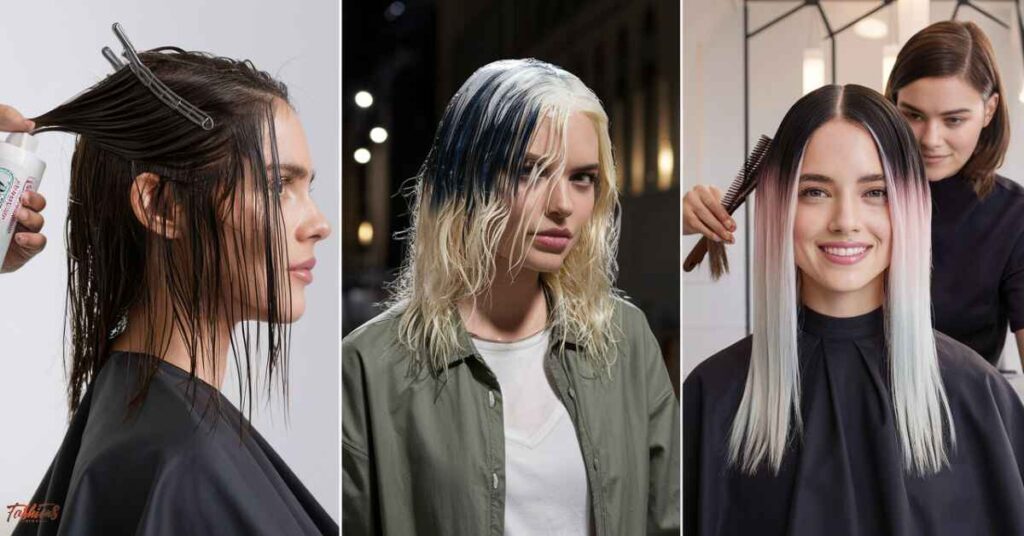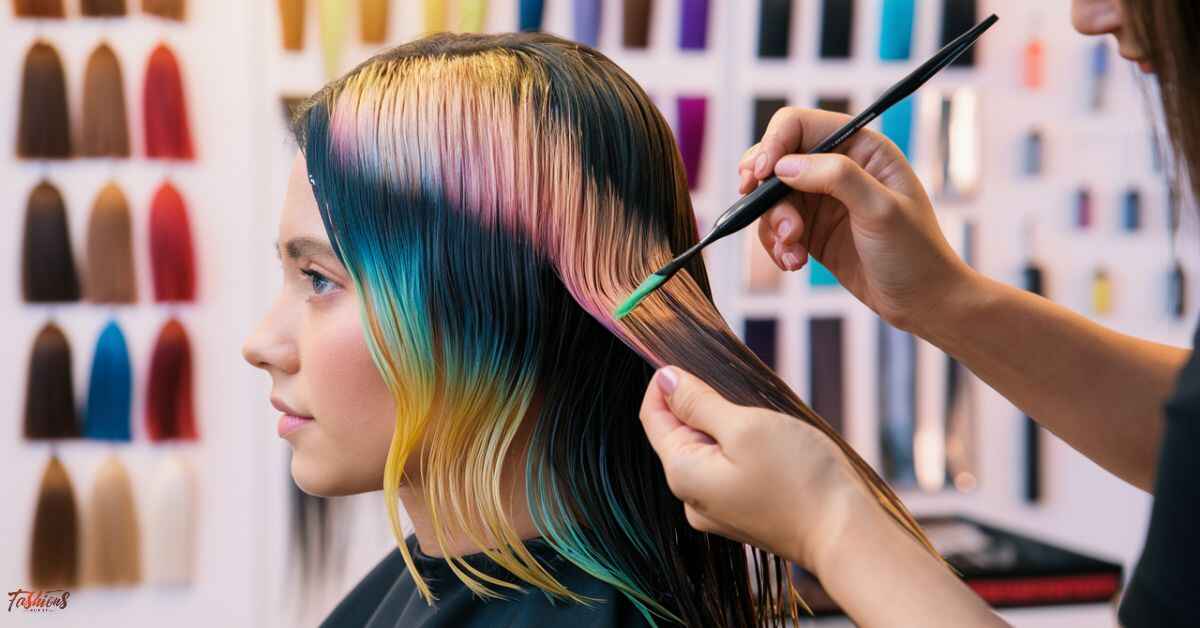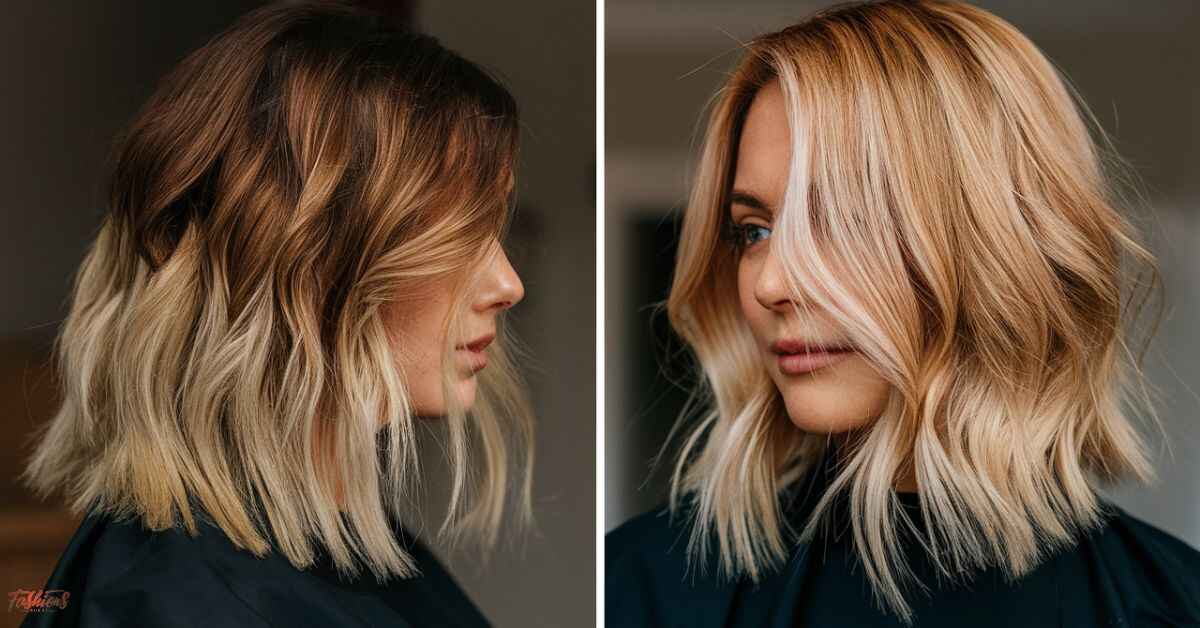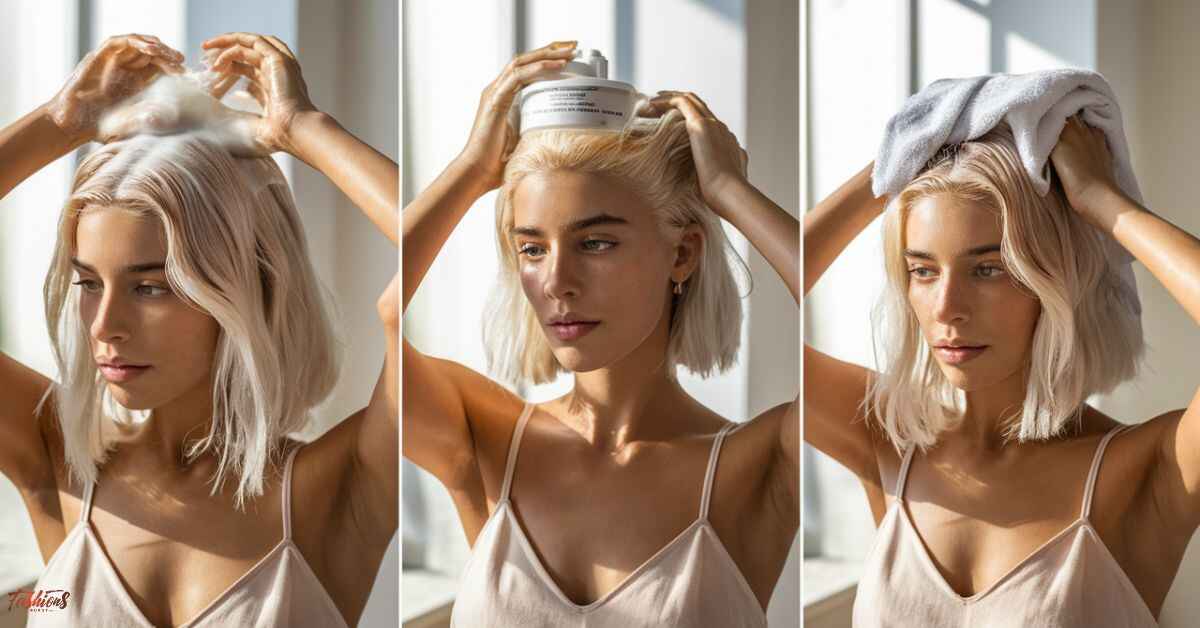Ever heard of the “wet balayage” trend taking over salons? While getting highlights is nothing new, this edgy technique challenges an old hair coloring rule – never bleach wet hair. Stylists are embracing a bolder approach by painting bleach directly onto damp strands.
In this comprehensive guide, we’ll dive deep into the burning question: can you really bleach wet hair safely? I’ll break down the pros and cons, so you can decide if damp bleaching is right for your mane. Whether you’re a bleach newbie or a seasoned blonde, this post has everything you need to know about coloring wet strands like a pro.
What is Wet Balayage?
The wet balayage trend has been gaining serious traction with its edgy, sun-kissed results. But what exactly is it? Balayage is a freehand highlighting technique where the stylist hand-paints bleach onto select sections of hair. This creates a gradual, natural-looking transition from roots to ends.
Traditional balayage is done on dry hair. However, the “wet balayage” method involves applying bleach directly to damp strands. This allows the bleach to diffuse more softly through the hair for a delicate, bright-yet-blended effect.
So why has wet balayage become so popular? For starters, the results mimic how hair would naturally lighten from sun exposure. The highlights appear less chunky and more seamless. Plus, roots can be left darker for lower maintenance between salon visits.
The Case For Bleaching Wet Hair
While bleaching wet hair may sound like a recipe for damage, there are actually some valid reasons stylists opt for this technique. Let’s explore the three main benefits:
Faster Processing Time
When you apply bleach to wet hair, it lifts and develops color faster than on dry strands. According to celebrity colorist Richy Kandasammy, damp hair can cut processing time in half.
On dry hair, it might take 45-60 minutes for the bleach to fully develop. But on wet hair, you’re looking at more like 20-30 minutes for the same lift, Kandasammy explains.
For busy clients pressed for time, this sped-up service is a game-changer.
Subtle, Sun-Kissed Color
Water dilutes the potent bleach, creating softer, more delicate highlights. So if you want just a whisper of color with minimal brassiness, wet balayage could be perfect.
These softly-blended ribbons mimic how hair would naturally lighten from sun exposure. The results are more lived-in and low-maintenance compared to chunkier foil highlights.
Enhanced Brightness for Pre-Lightened Ends
Wet bleaching works beautifully to “refresh” faded highlights in-between full salon appointments. After a regular balayage or full highlights, your stylist can go back over just the ends with bleach applied to damp strands.
“If a client’s roots and midlengths look fresh, but the ends need a boost, a quick wet balayage on the ends can breathe new life into the haircolor,” says Kandasammy.
This brightens up the ends with minimum damage since the lengths and roots are left alone. It’s an easy way to extend that just-left-the-salon vibrance.
Personal Experience: “As someone with naturally dark hair who highlights regularly, the wet balayage method has been a total game-changer. My stylist uses it to gently refresh my grown-out highlights between appointments. The sun-kissed, sunkissed results look so natural – but best of all, it’s quick and doesn’t leave my hair a fried, damaged mess like past highlight sessions did.”
Risks of Wet Bleaching
While those benefits sound great, bleaching wet hair does come with some serious risks you can’t ignore. The main issue? Hair is most fragile when wet.
When your strands are saturated, the outer cuticle layer opens up and lifts away from the inner cortex containing the hair’s pigment. In this vulnerable state, the powerful bleaching agents can penetrate deep into the hair shaft.
This increases the odds of severe damage like:
- Excessive dryness and brittleness
- Breakage and split ends
- Frizz and unruly texture
- Scalp irritation and sensitivity
Unless done with utmost precision by an experienced stylist, wet bleaching can quickly lead to hair disaster. Even with a skilled pro, you’re putting your strands at higher risk compared to bleaching dry hair.
When is Wet Bleaching Okay?
So with those risks in mind, is wet bleaching ever advisable? The short answer is yes – but only in very specific scenarios with guidance from an experienced colorist.
Salons may recommend wet balayage for:
- Subtle highlights (lifting just 1-2 shades lighter)
- Refreshing faded ends between full highlight appointments
- Enhancing and blending an existing balayage or highlight
Crucially, your stylist needs to assess your hair condition and color history first. They’ll determine if wet balayage can safely achieve your desired result without excess damage.
“I would never wet balayage high-maintenance blondes or anyone with extremely compromised hair,” advises Kandasammy. For those clients, I stick to balayage on dry strands for more control.
To ensure you’re a good candidate, be totally transparent with your stylist. Disclose any past chemical treatments, heat styling habits, and haircare routines so they can make an informed decision.
Read this blog: 15 Takuache Haircuts To Elevate Your Style Game In 2024
Prepping Hair for Bleach
Whether you go the wet or dry route, properly prepping your hair is key to a successful bleaching session. Here’s how to get strands in prime condition:
✓ Don’t shampoo for 24-48 hours before your appointment. This allows your hair’s natural oils and protective sebum to build up, which can help minimize scalp irritation.
✓ Deep condition in the weeks prior. Using a moisturizing mask or treatment will help hydrate and strengthen your strands. Look for pre-art smoothies and keratin blowouts in the two weeks leading up.
✓ Avoid heat styling tools like blow dryers or flat irons in the 5-7 days before. The high heat can roughen and open up the hair’s cuticle.
With hair that’s bouncy, hydrated, and protected from the get-go, you’ll get better results with less risk of extreme damage.
Post-Bleach Haircare Routine
Even if you have an amazing colorist, bleaching is an inherently damaging process. To keep your fresh color bright and hair healthy, you’ll need to tweak your haircare regimen.
Follow these tips for bleached strands:
Use color-protecting haircare. Switch to a shampoo and conditioner formulated specifically for chemically-treated hair. Look for sulfate-free options with UV filters to prevent premature fading.
Popular options:
- Pureology Hydrate Shampoo and Conditioner
- Redken Blondage Shampoo and Conditioner
- dpHUE Color Radiance Daily Shampoo and Conditioner
Deep condition weekly: Bleached hair requires extra TLC in the form of frequent deep conditioning treatments and hydrating hair masks. Try an intensive treatment like Olaplex No. 8 Bond Intense Hair Masque or Briogeo Don’t Despair, Repair! Deep Conditioning Hair Mask.
Limit heat styling: The more you can air dry and embrace heatless hairstyles, the better. When you must blow dry or use hot tools, always apply a thermal protectant spray or serum first.
Protect from UV exposure: Ultraviolet rays are public enemy #1 for color-treated hair. Wear a hat when spending extended time outdoors. You can also use a color-depositing product with UV filters like dpHUE Apple Cider Vinegar Hair Rinse.
Get regular trims: Trimming your ends every 6-8 weeks eliminates split ends before they can travel further up the hair shaft. If you notice excessive dryness or breakage, don’t wait – get to the salon ASAP.
Book toner/gloss refresh sessions: Salons offer quick glosses and toners between full highlight appointments to boost vibrancy, tone down brassiness, and add shine. These semi-permanent treatments can help extend the life of your color.
Avoid over-washing: Bleached hair shouldn’t be shampooed daily. The surfactants can quickly strip away your color and precious hydrating oils. Aim to wash only every 2-3 days.
Protect from chlorine and saltwater: Both swimming pools and the ocean can cause serious color distortion and dryness. If you’ll be taking a dip, wet your hair with fresh water first and coat with a leave-in conditioner. Consider wearing a snug swim cap to fully protect your strands.
Use proper brushing technique: Always detangle bleached hair gently with a wide-tooth comb or Tangle Teezer, working from the bottom up. Harsh brushing can snap off fragile strands. Microfiber towels and pillowcases are also recommended for reducing friction.
By adapting your haircare to support porous, bleached locks, you’ll be able to rock that bright blonde for longer with minimal damage.
Also read: How Much Are Hair Extensions?
Key Takeaways
Before you rush off to get that trendy wet balayage, let’s recap the most important points:
✓ Wet balayage involves applying bleach to damp hair for subtle, blended highlights
✓ It creates faster processing time and a soft, sun-kissed effect
✓ However, wet hair is more vulnerable to damage from harsh bleach
✓ Only experienced stylists should attempt wet bleaching in a controlled setting
✓ Prepping hair properly and following a specialized aftercare routine is crucial
✓ With precautions, wet balayage can produce stunning results on the right candidates
Frequently asked questions
Can you do a bleach bath on wet hair?
Yes, a bleach bath can be done on wet hair for a gentler lightening effect.
What happens if you put hair dye on wet hair?
The dye may be less intense and uneven, but it can provide a subtler color.
Does bleach deactivate when wet?
No, bleach continues to work as long as it remains moist.
How long should bleach sit on hair?
Bleach should sit on hair for 20-45 minutes, depending on desired lightness.
How to bleach dark hair without it turning orange?
Use a high-lift bleach and a toner to neutralize orange tones.
Does hair bleach still work if it dries?
No, bleach stops working effectively once it dries out.”
Conclusion
While the wet balayage fad may seem enticing for natural-looking highlights, bleaching wet hair isn’t something to DIY. The risks of damage are high when hair’s cuticle is open and porous.
However, with the right precautions from a skilled colorist, carefully controlled wet bleaching can produce a gorgeous, sun-kissed effect. This method requires lower maintenance than traditional highlights.
Just be sure to follow all the haircare rules before and after. Maybe wait for that daring damp dye job until your strands are healthy enough to handle it.. At the end of the day, the choice is yours, but now you’re armed with all the facts!
So tell me, would you ever let your stylist bleach your wet hair? I’d love to hear your thoughts and experiences in the comments!











